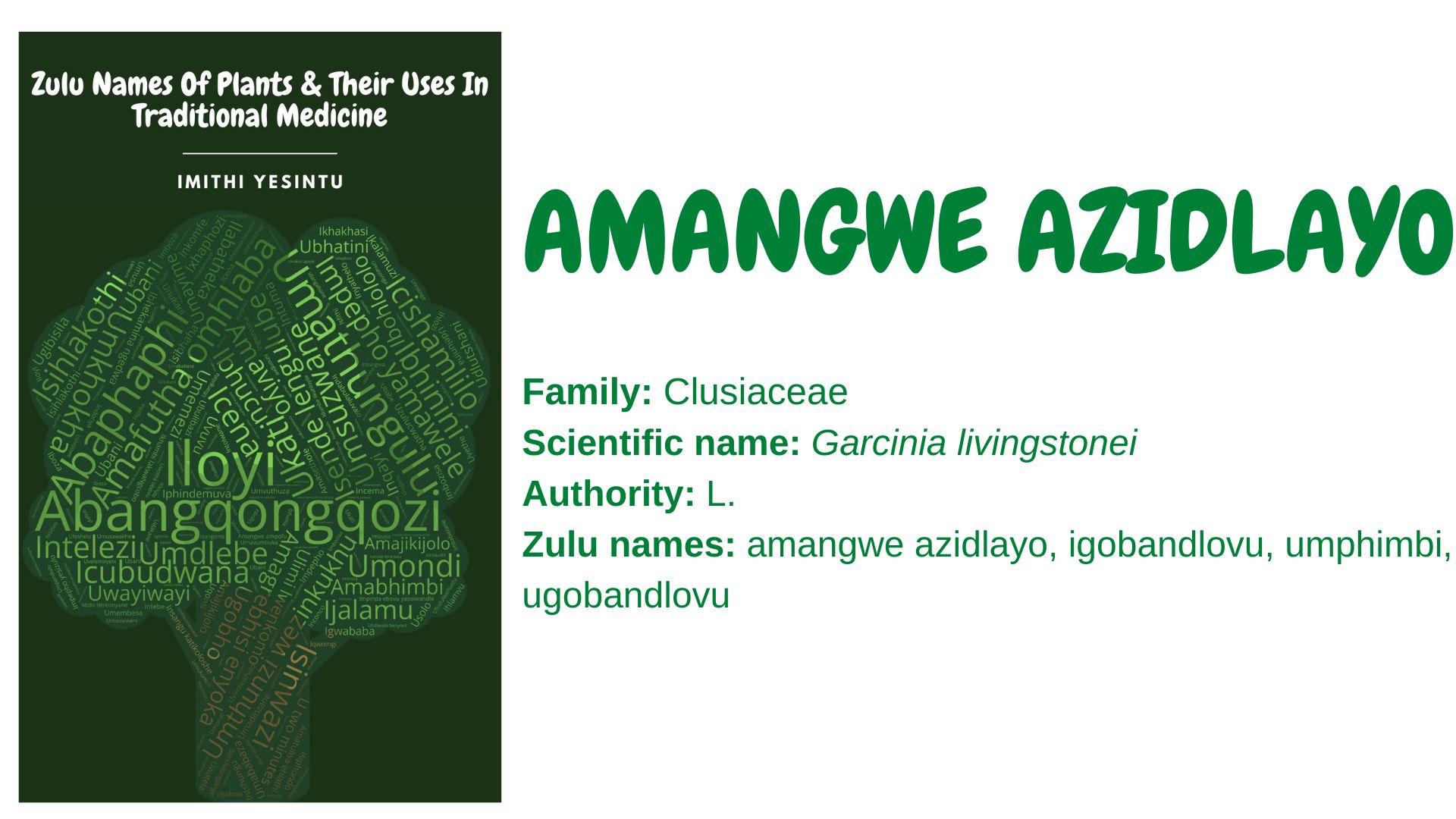Family: Clusiaceae
Scientific name: Garcinia livingstonei
Authority: L.
Synonyms: Garcinia affinis (Chiov.) Chiov., Garcinia angolensis Vesque, Garcinia baikeana Vesque, Garcinia ferrandii Chiov., Garcinia kilossaria Engl., Garcinia pallidinervia Engl.
Zulu names: amangwe azidlayo, igobandlovu, umphimbi, ugobandlovu
Other names: African mongosteen, imbe fruit, Livingstone’s Garcinia, Lowveld mangosteen (English), Afrika-geelmelkhout (Afrikaans)
Plant description: G. livingstonei is a small tree that occurs in riverine forests, woodland, and thicket habitats in the Lowveld. It has leaves, flowers in dense clusters that are yellow, greenish, or white in colour, and nutritious yellowish-orange berry fruits containing a single large seed.
Uses:
- The edible fruits are eaten as food.
- The fruits are also used to make refreshing alcoholic and nonalcoholic drinks.
- The bark is dried and ground to fine powder and applied directly to treat piles.
- The powdered bark is used to make medicine that is applied on the incision made in the skin during ukugcaba, to treat illnesses associated with the vertebral column running through to the head.
- The powdered bark is rubbed into an incision made in the skin (ukugcaba), to immunise the body against sickness.
- The powdered bark is added to hot water to make an infusion that is drunk as tea to strengthen the blood of a person with weak blood.
- The powdered bark is applied to treat burns and respiratory infections, including tuberculosis.
- The powdered bark is used to make poultice to whiten the skin.
- The bark is used to treat parasitic diseases, fever, and cough.
- The roots are used to make an infusion that is taken by pregnant women to treat pain and to aid in childbirth
- The powdered root infusion is taken as an aphrodisiac and to treat male sexual disorders, such as impotence.
- The root infusion is gargled to relieve toothache.
- The roots are used for steaming to relieve sore eyes.
- The hard wood is used for construction and making tool handles, kitchen utensils, and pegs.
- The tree is cultivated as an ornamental fruit tree.
Safety precaution:
Using traditional medicine responsibly can enhance your overall health and well-being. Misuse and abuse can lead to complications. You can inquire about the correct use of traditional medicine from a knowledgeable herbalist and practitioner. You can also visit imithiyesintu.co.za or email: info@imithiyesintu.co.za to learn more about traditional medicine
References and further reading:
- Arnold, H.J. and Gulumian, M., 1984. Pharmacopoeia of traditional medicine in Venda. Journal of Ethnopharmacology, 12(1), pp.35-74.
- Cunningham, A.B., 1998. An investigation of Herbal Medicine Trade in Natal-Kwazulu.
- Kaikabo, A.A., Samuel, B.B. and Eloff, J.N., 2009. Isolation and activity of two antibacterial biflavonoids from leaf extracts of Garcinia livingstonei (Clusiaceae). Natural product communications, 4(10), p.1934578X0900401010.
- Kaikabo, A.A. and Eloff, J.N., 2011. Antibacterial activity of two biflavonoids from Garcinia livingstonei leaves against Mycobacterium smegmatis. Journal of Ethnopharmacology, 138(1), pp.253-255.
- Khumalo, G.P., 2018. An inventory of the most popular medicinal barks sold on Johannesburg muthi markets and the antimicrobial activity of selected extracts and isolated chemical compounds. University of Johannesburg (South Africa).
- Khumalo, G.P., Sadgrove, N.J., Van Vuuren, S.F. and Van Wyk, B.E., 2021. South Africa’s Best BARK Medicines Prescribed at the Johannesburg Muthi Markets for Skin, Gut, and Lung Infections: MIC’s and Brine Shrimp Lethality. Antibiotics, 10(6), p.681.
- Lim, T.K. and Lim, T.K., 2012. Garcinia livingstonei. Edible Medicinal And Non-Medicinal Plants: Volume 2, Fruits, pp.66-70.
- Manda, Z.C., 2020. DNA barcoding: an alternative approach for the identification of medicinal bark species traded at the Faraday medicinal market, Johannesburg, South Africa. University of Johannesburg (South Africa).
- McGaw, L.J., Lall, N., Meyer, J.J.M., and Eloff, J.N., 2008. The potential of South African plants against Mycobacterium infections. J. Ethnopharmacol. 119, pp. 482–500.
- Nossier, F.H., Ashour, R.M., Abdel-Monem, A.R. and Elsayed, A.M., Garcinia livingstonei T. Anderson: A Potential Source for Bioactive Con-stituents.
- Pooley, E., 1997. The complete field guide to the trees of Natal. Natal Flora Publications Trust, Durban.
- Samuelsson, G., Farah, M.H., Claeson, P., Hagos, M., Thulin, M., Hedberg, O., Warfa, A.M., Hassan, A.O., Elmi, A.H., Abdurahman, A.D. and Elmi, A.S., 1992. Inventory of plants used in traditional medicine in Somalia. II. Plants of the families Combretaceae to Labiatae. Journal of Ethnopharmacology, 37(1), pp.47-70.
- Van Wyk, A.E. and Van Wyk, P. 1997. Field guide to the trees of southern Africa. Struik, Cape Town.
You Can Order Your Copy Of The Book By Emailing: info@imithiyesintu.co.za
Feel Free To Add Other Uses Of This Plant In The Comment Section Below:

